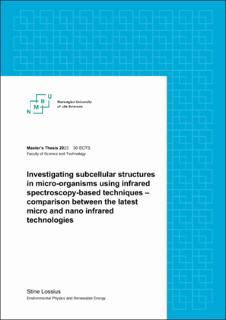| dc.description.abstract | Infrared spectroscopy is a widely used method to investigate biological samples. The approach enables chemical information of molecules by evaluating the wavenumber dependent absorption of the sample. Infrared microscopic techniques such as Fourier transform infrared microspectroscopy (FTIR) achieve chemically rich spectra with a spatial resolution at the diffraction limit. Nano infrared spectroscopy techniques such as Optical-probed hotothermal induced tnfrated microspectroscopy (O-PTIR) and Atomic Force Microscopy-based infraied spectroscopy (AFM-IR) circumvent the diffraction limit of infrared radiation, and the techniques are promising for obtaining high quality subcellular spatially resolved spectra.
The aim of this thesis is to compare FTIR microscopy and nano infrared techniques for their ability to achieve subcellular resolved spectra in the analysis of biological cells.
For FTIR microscopy, the newly developed approach of deep-learning empowered 3D infrared diffraction tomography is used. The method takes advantage of the scattering features that arise in infrared microspectroscopy. Scattering effects change the absorbance spectra of biological cells considerably, making it hard to analyze the chemical signatures in the sample. Thus, a lot of effort has been made to remove the scattering effect, such as extended multiplicative signal correction, and further by deep learning algorithms, which are less computationally expensive. Instead of looking at the scattering as a disturbing effect, deep-learning empowered 3D infrared diffraction tomography solves the inverse scattering problem and retrieves the pure absorbance spectrum of the cell wall and cell interior of biological cells. This is possible by taking advantage of scattering chemical features that are characteristic for the chemical and physical properties of the sample. The approach makes it possible to obtain subcellular information from structures of biological samples that have sizes below the diffraction limit of microspectroscopic instruments such as FTIR.We show in this thesis that with intact cells with a diameter size bigger than 5 μm such as Phaffia rhodozyma it is possible to get high chemical absorbance spectra of the cell wall and cell interior using the deep-learning empowered 3D infrared diffraction tomography.
O-PTIR is theoretically limited by a green laser of 532 nm and the AFM-IR is only limited by the tip radius of the cantilever, giving a spatial resolution down to 50 nm. In order to obtain chemical information from the cell wall and cell interior, biological samples were sectioned. The cells were embedded in epoxy, which is necessary to make nanometer sections. The epoxy shows strong signals in the infrared absorbance spectra, leading to highly contaminated spectra. We show that it is impossible to correct for the epoxy and to obtain chemical information from the cell wall and cell interior from O-PTIR spectra. The AFM-IR sectioned cells were also strongly affected by epoxy, especially in the region between 1200 cm−1 and 1000 cm−1. However, we were successfully able to distinguish the cell wall and cell interior due to chemical differences in the spectra.
In a recent study, in-depth measurements of intact biological cells were performed with OPTIR. The study claims that it is possible to obtain in-depth chemical information about intact cells. However, there are a lot of uncertainties with this technique. With a limited understanding of the optical instrumentation, it is impossible to be sure that the chemical information obtained by in-depth measurements originates from that focus point. Most likely, the signal comes from the whole laser path of the probe laser and not only from the measured depth of the sample. Therefore, it is not possible to use this approach to obtain subcellular chemical information. However, the technique allows high-quality signals from different depths, giving an approximation of the thickness of the cell. | |
